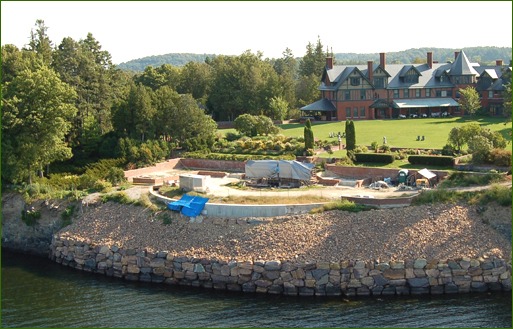Case Study: Rehab and Restoration
All in a Summer’s Work

Preserving and restoring Vermont’s majestic Shelburne Farms means that masons, apprentices and interns must analyze historic processes and materials, and use technology to recreate objects and create fresh treatments.
In 1886, members of the wealthiest family in America, the Vanderbilts, began creating a model agricultural estate in Vermont, overlooking Lake Champlain. Dubbing it “Shelburne Farms,” they hired two of the nation’s most famous planners: Frederick Law Olmsted Sr., the “father of landscape architecture,” and architect Robert H. Robertson. The property featured innovative agricultural and land-use practices, plus a horse-breeding enterprise and a grand family residence.
But over the years, the family’s fortunes changed, and the farm’s majestic structures were neglected. In 1972, the site became a non-profit environmental education center.
Today, Shelburne Farms is a 1,400-acre working farm (its dairy herd produces fine cheeses) and a National Historic Landmark. It has become a magnet for New England’s top historic preservationists. Their presence attracts talented summer interns and apprentices, eager to acquire hands-on experience.
Douglas Porter is the site’s architectural conservator and project manager. He has a M.S. degree in Historic Preservation and holds a research faculty appointment at the University of Vermont’s School of Engineering.
Porter feels a powerful bond with past builders. “Much of what we do in historic preservation is dictated by artisans who are long gone,” he says. “I think of them whenever I work on a project. And when we train new craftspeople, we’re extending the past into the future.”
That training often includes exposure to scientific methodologies. Any given project might entail: geotechnical assessments of below-ground conditions; laboratory analysis of old brick, mortar and concrete; 3-D laser-scanning of existing decorative elements, for accurate replication of lost or damaged pieces; testing of new treatment formulas (which Porter says has led to improved methods for repairing cast stone); and new technologies as they emerge.
Currently, Porter is overseeing restoration of the Farm’s Formal Garden, which lies between Shelburne Inn and the lake bluff. This article focuses on the brick wall of its central feature, a fountain and pool.
Restoring the Fountain Wall
The fountain wall, built in 1914, is a solid, three-wythe brick retaining wall, set in a Flemish bond. Oddly, it had been built without a concrete back wall. Thus, the bricks in direct contact with the soil had decomposed badly. (Throughout the Formal Gardens, nearly 12,000 bricks would eventually be replaced.)
The project team included four masons with strong preservation experience: James Duggan, Preservation Unlimited, Montpelier, Vt.; Ryder Owens and Rae Berolzheimer, Petra Terra, Wilmington, Vt.; and John Wastrom, Portsmouth, N.H., plus an equal number of interns, apprentices and laborers.
They carefully dismantled the brickwork, salvaging as many bricks as possible for cleaning and reuse. A reinforced concrete wall was erected to prevent future brick deterioration.
They got a lucky break during their search for replacement bricks. A nearby salvage company had what seemed to be the same type of brick used in the original wall, and even made by the same manufacturer, Drury Brickyard (1850s – 1970s). Porter had samples of the replacement bricks tested for soluble salt content, compression strength and modulus of rupture. They passed nicely. And, since the original mortar had held up well, the project team duplicated it.
The team needed to decide how to flash the wall’s deep, curved cavity. Among their options was an innovative, all-in-one cavity-drainage system, TotalFlash. It contained multiple drainage components and all necessary installation hardware, factory-assembled onto handy-sized panels of flexible flashing. They asked the manufacturer, Mortar Net USA, of Burns Harbor, Ind., whether it could be made to fit behind the fountain’s geometrically unique brickwork.
Earl Bickett, general manager of Mortar Net, agreed to custom-produce TotalFlash panels that would be twice the standard height, and to omit the usual stainless-steel drip-edge (which would be fabricated locally, to match the wall’s curvature).
After further research, the team decided TotalFlash best met their technological standards. When the factory-assembled panels arrived and were installed, Porter was pleased. Everyone had learned something new.
During bricklaying, care was taken to replicate the wall’s original appearance in every detail. The arched and circular patterns were turned over templates based on historic photographs. The restored walls were tied to the concrete retaining walls using stainless-steel ties and standards as anchors.
When they finished, the team could almost hear ghostly applause from the original architect.
Porter still has many projects ahead of him at Shelburne Farms. They will all demand a good bit of science before and during the actual labor. But you can tell he loves unraveling the mysteries of long-dead builders and far-outdated materials.
“Many historic trade-processes have been lost,” he says. “Our job is to figure out what they were, why they worked, and how to duplicate them?Ķwithout leaving any fingerprints.”
